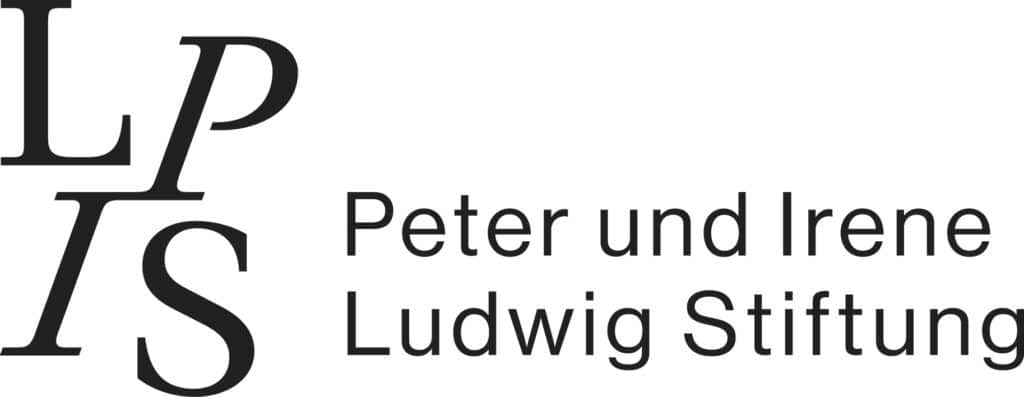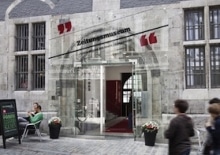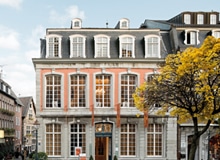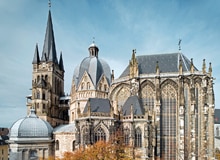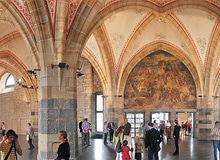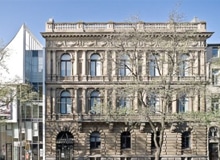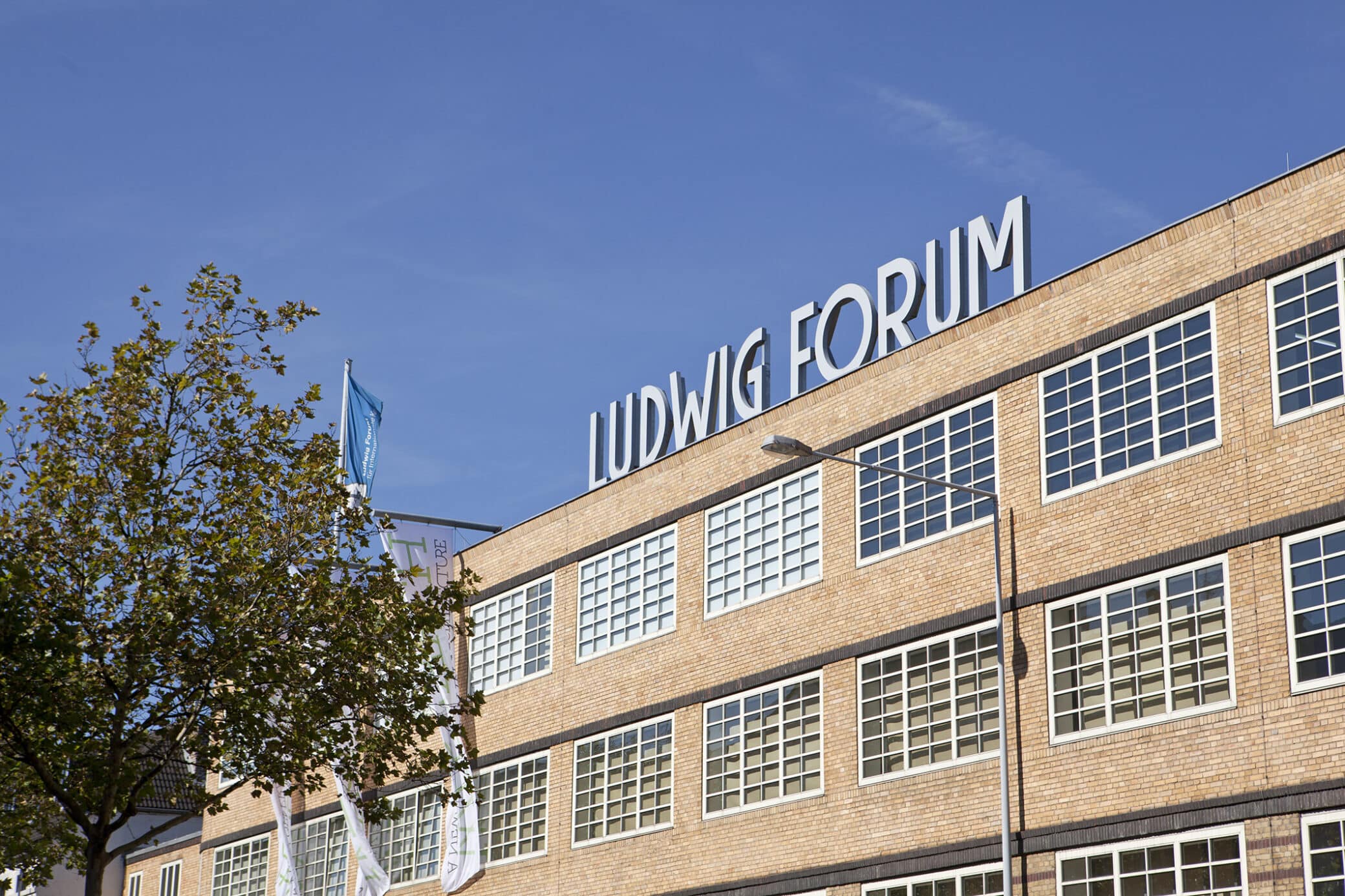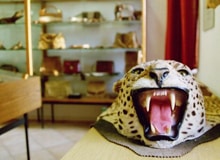Restoration of Allen Jones’ group of figures Hatstand, Table and Chair
When Peter Ludwig discovered Allen Jones’ group of figures “Hatstand, Table and Chair” in 1970 in Cologne’s Galerie Zwirner, he bought it on the spot. From then on, the ensemble, which had only been produced a year earlier, was on show in Aachen’s Neue Galerie.
The group consists of three life-sized female figures that serve as pieces of furniture – as a hatstand, a table and a chair. And in fact, before they moved into the Neue Galerie, they had actually been used as furniture, as evident from the signs of wear and tear. Because over the years the ensemble was frequently loaned out to other museums, these original signs of usage were joined by further traces of damage. Too much exposure to sunlight and occasional incidents of vandalism did the rest. In 2006/2007, the Ludwig Forum’s conservators Julia Rief and Christina Sodermanns tackled the job of repairing the damage. The works took about three months. The team received active assistance from a professional hairdresser from Aachen and a textile restorer. The project was funded by the Ludwig Foundation – and by Irene Ludwig herself, even though, at the time her husband made the acquisition, she was not at all pleased about it. She found Jones’ piece “indecent”.
Restoration report
The art object
Jones’ sculpture “Hatstand, Table and Chair” are made of glass fibre reinforced polyester resin. They are dressed in real clothes and wigs. The ensemble is arranged on furs. The standing female figure, with arms bent out sideways and the palms of her hands opened upwards, represents the hatstand. Her skimpy clothing consists of a pair of boots, a thong and collar made of purple leather, and a transparent silk bolero. The skin-tight high heel boots are thigh-length and tightly laced to the very top with matching colour laces. Recesses were worked into the figure’s thighs so that the boots are actually inlaid into her legs. Her blouse of transparent silk batiste is open at the front and the back. Under her breasts and at her cuffs, thin light-coloured drawstrings are run through the hems to gather the blouse.
The figure lying on her back forms the chair. Her legs are drawn tightly up to her chest so that the backs of her thighs form the base for a leather seat. This is mounted on a square acrylic glass plate and fastened with a leather belt. Her arms are stretched along the sides of her body and her head is slightly raised. The lady is dressed in black leather: short panties, long black gloves and boots.
The table is formed by a female figure kneeling on all fours bearing a large glass plate on her back, which is fastened into her shoulder blades and buttocks with four chromed screws. She is staring down at the reflection of her face in a mirror that lies beneath her on the floor. She is dressed in a black leather underbust corset that only encloses her midriff, golden-yellow glittering lurex hot pants, long black leather gloves and boots laced up the back.
All three figures wear wigs. Their artistically stylised makeup – eye shadow, rouge and lipstick – is rounded off with false eyelashes.
Material
Allen Jones prepared working drawings for the sculptures, and then had them produced professionally under his directions. The final figures, made of glass fibre reinforced polyester resin, were primed with several coats of nitrocellulose lacquer and polished to create a smooth surface for the final paint layer. Lucina della Rocca, a freelance artist, took on the job of painting the skin of the figures with broad brushstrokes in acrylics (Rowney Cryla Colour). She ensured that there were slight individual differences in their makeup.
The materials used, polyester resin, nitrocellulose lacquer and acrylic paints, were verified by analysis (ICN). The gloves were purchased from “Weis”, a store that used to be located in London’s Shaftesbury Avenue. The boots were tailor-made by the bespoke London shoemakers “Annello & Davide”. The remaining leather garments were designed by the British fetish fashion designer John Sutcliffe. The silk batiste blouse and the lurex hot pants came from fashion designer Zandra Rhodes.
Damage report
For the most part, the figures were in good condition. The damage, primarily due to wear and tear, over-exposure to light and occasional vandalism, was restricted to the clothing and accessories. The strap connecting the collar and the thong of the hatstand was stolen in 1989 or 1990. A leather retailer in Aachen produces a replacement strap, but this was slightly darker than the original. A first restoration of the blouse was undertaken in 1991, as the thin material had already become fragile in areas under heavy strain. At the Lisbon World Fair in 1998, visitors cut out two large pieces of cloth on the shoulders. The edges of the holes were frayed and had upright fibres, indicating that a pair of nail scissors was probably used.
Condition of the leather
Examinations showed that all elements were made of superficially dyed glacé leather (Göpfrich Leather Museum Offenbach). As the leather items came from several designers or manufacturers, it was no surprise to find variations in the material quality and thus the state of preservation. Mainly on the purple boots of the hatstand, there were numerous traces of mechanical damage. Especially on the insides of the thighs, poorly glued fissures and hooks were documented. In addition, these boots had shrunk to different degrees, which explained why the top edge on the upper thigh was now so conspicuous, and the consistent silhouette intended by the artist was interrupted. The leather of the seat cushion and the mannequin’s gloves were seriously worn and degraded. The gloves, being made of particularly thin leather, were worn through at the knuckles and fingertips. In some places, the fingers stuck through and small shreds of leather stood out. This damage can be ascribed to visitors intentionally treading on the sculptures’ fingers.
The seat cushion and gloves were extremely faded and no longer looked black but greenish instead. The leather thong had a large dark-brown stain on it. The leather was hard and brittle in that area – probably a paint over job that had discoloured with the passage of time.
Condition of the textiles
The textile elements comprise the blouse, the boot laces and the hot pants. Over the years, the originally light-coloured, possibly even white material of the organza blouse had become grey and unsightly. Because the blouse is made of a very thin, transparent and loosely-woven fabric, dirt had penetrated deep into the woven structure.
Horizontal fissures had developed in many places. These were particularly extreme where the blouse touched the figure or had been stretched around convex bends. In addition to the mechanical strain, material fatigue through exposure to light may also have played a role here. Older repairs, some of them carried out with comparatively course thread, had puckered the fabric at the lower hem and at the bust darts. The boot laces showed clear signs of damage due to fading. The lacing on the purple boots in particular was extremely shot.
Wigs
The “Hatstand” and the “Table” both have artificial hair wigs; the wig on the “Chair” is of human hair. The wigs were fastened with two-sided adhesive tape. They were all very dusty, and the coiffures had lost their shape. This impression was intensified in the case of the “Hatstand” by the fact that the wig had slipped forward onto the forehead and had thinned out considerably at the back of the head.
Rescue measures
Leather
The leather of the gloves and the seat cushion had already deteriorated considerable, which excluded the option of applying water-based consolidation methods. In a comprehensive series of tests, it was established that, in addition to good leather consolidation properties, the sensitivity of the paint layer under the gloves was also a factor to be taken into account in the consolidation process. To avoid dissolving the acrylic paint, the restorers started looking for a viscous adhesive with an adequate depth of penetration and at the same time a fast rate of evaporation. Use of methylcellulose in isopropanol showed very good results. After the first consolidation coat, pigment was added to the gel in order to directly darken the faded zones. Further coats allowed the required shine to be achieved.
The fissures in the purple boots were smoothened, filled with fibres from an old chamois leather in methylcellulose, and retouched.
Textiles
The fact that the laces of the purple boots were originally dyed to fit to the colour of the leather is still evident in concealed places, for example in the knots of the bows. This original tone was reconstructed with Dupont silk dyes. Tests with dry and wet cleaning methods indicated that neither of these two approach would significantly reduce the grey discoloration of the blouse. (Thanks are due for these results and other implemented measures to the work and documentation done by the textile restorer Laurence Becker.) But it was possible to undo the old sewing repairs. To stabilise the fragile silk, a second, inner blouse of sheer crepeline (100 percent silk) was sewn in. This backing support was added piece by piece. Crepiline has a looser weave than the original organza and thus hardly affects the original transparency of the garment. However, it had to be applied at a 45 degree angle to avoid creating a moiré effect. Fissures and tears were additionally consolidated to the backing support using self-couching and satin stitches. The two larger holes on the shoulders were patched with inlays of organza dyed to match the colour tone of the blouse.
Wigs
The wigs came off easily, as the adhesive of the double-sided tape had deteriorated and was in the process of dissolving. Cleaning of the wigs was handled by master hairdresser Herbert Willekens from the Aachen hair salon W. Prömper. He repeatedly rinsed them out in standing water until there were no more visible remnants of dirt, then rinsed them in a bath of softener so that they could be dressed to their original styles. All three wigs benefited greatly from this treatment. They were put back on the figures with a special double-sided adhesive tape that is also used to fasten wigs on human heads.
Surface paint
The acrylic pains turned out to be extremely solvent-sensitive. With stubborn deposits of dirt, especially on the buttocks of the hatstand, it was possible to improve the cleaning result through the additional abrasive effect of attapulgite. Small amounts of putty were used on the fissures in the hatstand’s hips area, and the hole on her chin was evened out with chalk putty. These places were than retouched with water-soluble wax crayons (Caran d’Ache), which can be removed again using water or white spirit. Finally, a gentle polish achieved the required sheen.
